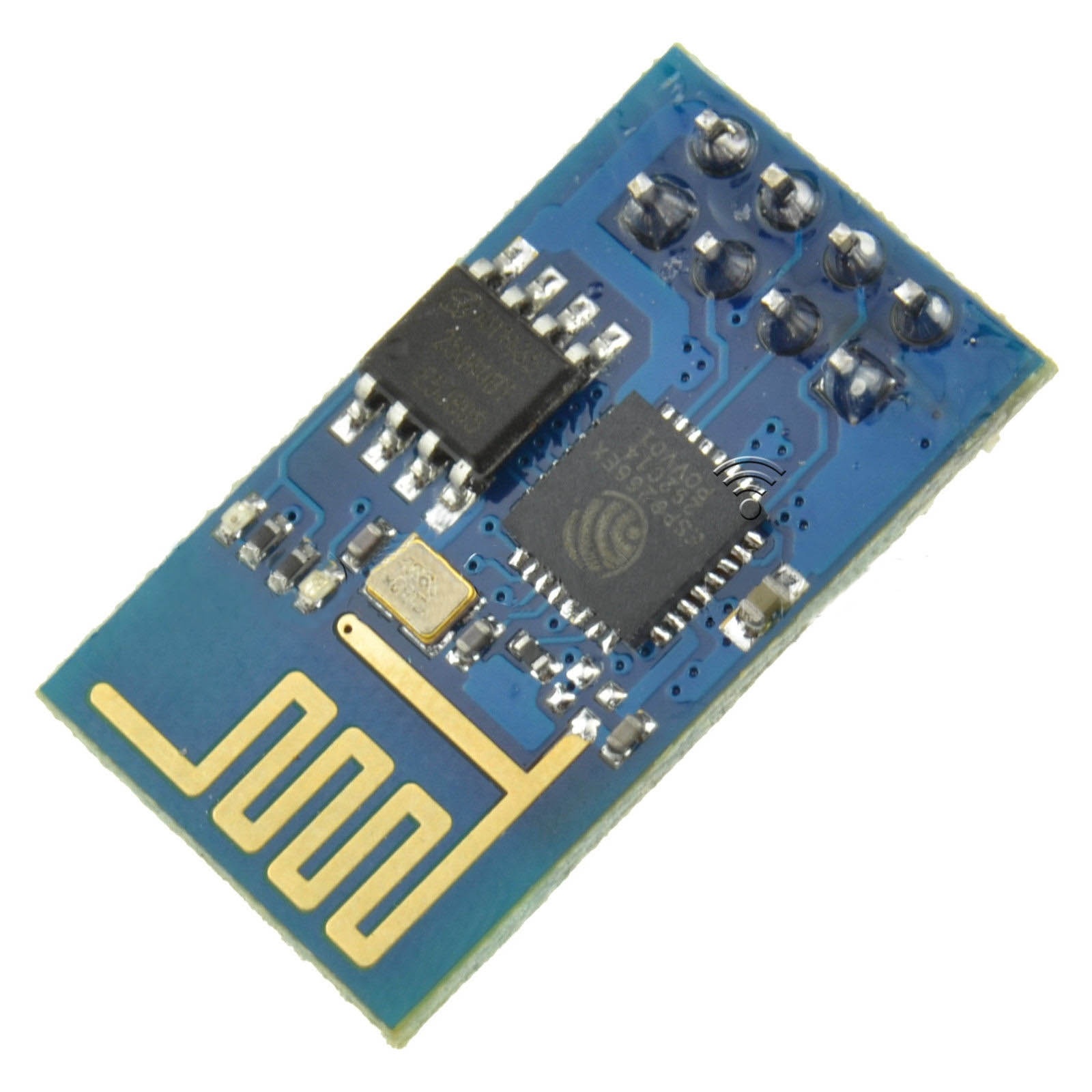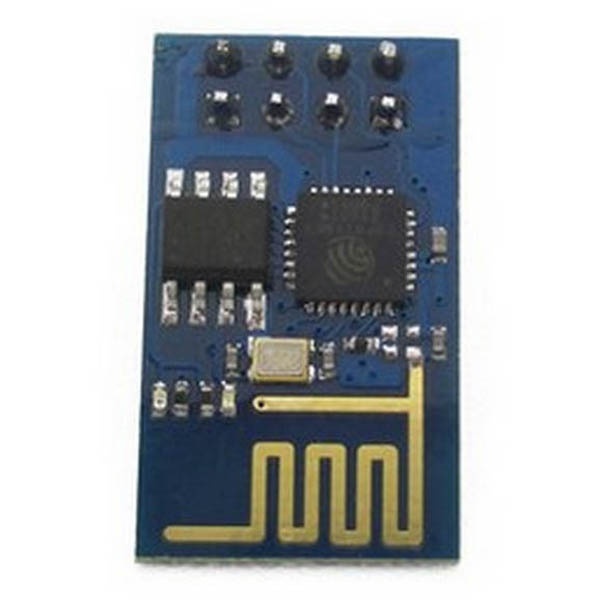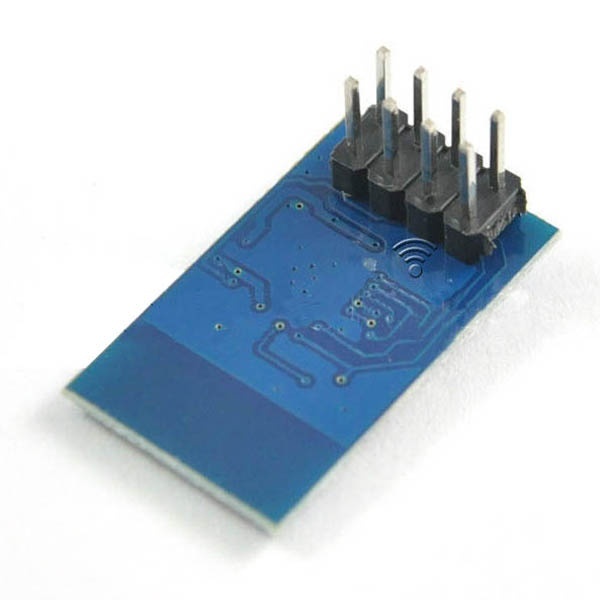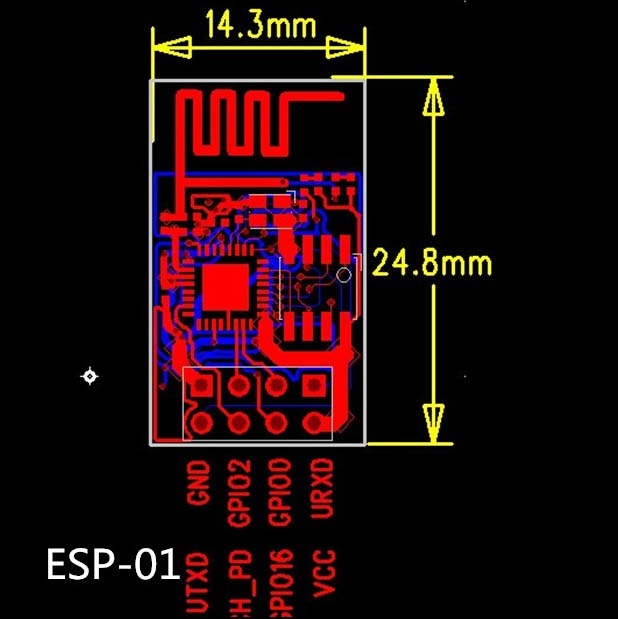ESP8266 Serial Esp-01 WIFI Wireless Transceiver Module Send Receive STA+AP SGV379A
ID: 257 Kategorie: ESP8266
Menge: 0 Position:

Opis
Moduł WiFi oparty na chipie ESP8266. Działa w standardzie WiFI 802.11 b/g/n na częstotliwości 2,4 GHz. Wyposażony jest w 8 wyprowadzeń - raster 2,54 mm, z czego 3 to GPIO. Posiada wbudowaną pamięć Flash 512 kB, diodę LED i antenę PCB. Wymiary płytki to 24,8 x 16 mm.
|
W naszej ofercie znajdziesz moduł ESP-01 Black ze zwiększona ilością pamięci Flash do 1 MB. |
Cechy modułu ESP-01
Poniżej cechy, które wyróżniajÄ… moduÅ‚ ESP-01 na tle caÅ‚ej rodziny ESP-XX.
- Posiada 8 wyprowadzeń:
- 3 x GPIO - wyjścia/wejścia cyfrowe
- 2 x UART (TX, RX) - do komunikacji np. z Arduino
- Montaż: THT:
- Raster wyprowadzeń: 2,54 mm
- Wyposażony w wbudowaną antenę PCB
- Wymiary: 24,8 x 16 mm
Podłączenie
ModuÅ‚ posiada 8 pinów, wyprowadzonych na dwurzÄ™dowÄ… (2x4) listwÄ™ goldpin raster 2,54 mm.
| Pin | Opis |
|---|---|
| Vcc | Zasilanie zasilanie 3,3 V, pobór prÄ…du do 300 mA. |
| GND | Masa układu. |
| Tx | Nadajnik interfejsu szeregowego UART. |
| Rx | Odbiornik interfejsu szeregowego UART. |
| RST | Reset układ - aktywowany stanem niskim. W czasie normalnej pracy należy podać stan wysoki. |
| CH_PD |
Power down - podanie stanu niskiego powoduje przejście w tryb uśpienia. Do aktualizacji oprogramowania oraz komunikacji przez UART, należy podać stan wysoki (3,3 V). |
| GPIO0 |
Wyprowadzenie GPIO nr 0. Do aktualizacji, należy podać stan niski (połączyć z GND). |
| GPIO2 | Wyprowadzenie GPIO nr 2. |
|
Produkt kompatybilny z Arduino Instrukcję połączenia modułu z Arduino można znaleźć na blogu majsterkowo, w serwisie nurdspace.com oraz w przygotowanym przez nas poradniku.
Płytka toleruje napięcie 3,3 V. Dlatego też należy wybrać Arduino pracujące z napięciem 3,3 V lub zastosować konwerter. |
Specyfikacja
- Napięcie zasilania: 3,3 V
- Napięcie pracy wyprowadzeń: 3,3 V
- Pobór prÄ…du do 300 mA
- Wspiera standard WiFi WiFi 802.11 b, g, n
- Pracuje na częstotliwości 2,4 GHz
- Wspiera zabezpieczenia WPA / WPA2
- Może pracować w trybie AP (Access Point), STA (standalone) oraz AP+STA
- Moc nadajnika: 19,5 dBm
- Wspiera komendy AT
- Posiada wbudowaną pamięć Flash: 512 kB
- Komunikuje siÄ™ poprzez interfejs szeregowy UART
- Posiada wbudowanÄ… antenÄ™ PCB
- Wyposażony jest w interfejsy komunikacyjne: SPI, UART, SDIO
- Posiada 8 wyprowadzeń raster 2 mm
- 3 x GPIO - wyjścia/wejścia cyfrowe
- Montaż: przewlekany - raster 2,54 (złącza goldpin)
- Wymiary: 24 x 14 mm
Description:
ESP8266 is a highly integrated chip designed for the needs of a new connected world. It offers a complete and self-contained Wi-Fi networking solution, allowing it to either host the application or to offload all Wi-Fi networking functions from another application processor.
ESP8266 has powerful on-board processing and storage capabilities that allow it to be integrated with the sensors and other application specific devices through its GPIOs with minimal development up-front and minimal loading during runtime. Its high degree of on-chip integration allows for minimal external circuitry, and the entire solution, including front-end module, is designed to occupy minimal PCB area.
Features:
SDIO 2.0, SPI, UART
32-pin QFN package
Integrated RF switch, balun, 24dBm PA, DCXO, and PMU
Integrated RISC processor, on-chip memory and external memory interfaces
Integrated MAC/baseband processors
Quality of Service management
I2S interface for high fidelity audio applications
On-chip low-dropout linear regulators for all internal supplies
Proprietary spurious-free clock generation architecture
Integrated WEP, TKIP, AES, and WAPI engines
Solutions
Supports APSD for optimal VoIP applications
Patented spurious noise cancellation algorithm for integration in SOC applications
Supports Bluetooth co-existence interface
Self-calibrated RF to ensure optimal performance under all operating conditions
Zero factory tuning
No external RF components
Specifications:
802.11 b/g/n
Wi-Fi Direct (P2P), soft-AP
Integrated TCP/IP protocol stack
Integrated TR switch, balun, LNA, power amplifier and matching network
Integrated PLLs, regulators, DCXO and power management units
+19.5dBm output power in 802.11b mode
Power down leakage current of <10uA
Integrated low power 32-bit CPU could be used as application processor
SDIO 1.1/2.0, SPI, UART
STBC, 1¡Á1 MIMO, 2¡Á1 MIMO
A-MPDU & A-MSDU aggregation & 0.4ms guard interval
Wake up and transmit packets in < 2ms
Standby power consumption of < 1.0mW (DTIM3)
1. High quality & low price
2. LWIP agreement
3. Support 3 modes: AP, STA, AP+STA
4. Perfect and simple AT commands
Warnings:
This module requires a 3.3 volt supply for VCC, and 3.3V logic. It is not 5V tolant. Connect RX or TX on 5V Arduino will
destroy this module. You must use a logic level converter, or a 3.3V Arduino
The 3.3V supply on the Arduino Uno has inadequate current capabilit to power this module. You must provide a separate,
higher 3.3V supply(about 300mA or better)
The ESP8225 module is very new on the market and support and documentation for it is currently very limited.
Package included£º1 x Wireless Transceiver Module
NOTE:As the effect varies from monitor to monitor, there is irrevocable slightly difference in colors between the color showed on your monitor and the real one, So if dear you can not accept this very little difference, be cautious before you making the orders.thanks for understanding.




